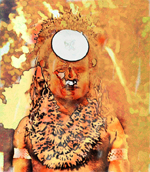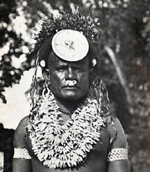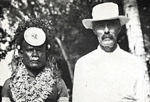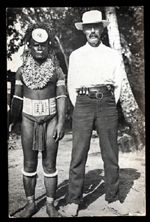Oliver Wendell Holmes1
In 1864 Oliver Wendell Holmes made these predictions as a part of his campaign to promote the use of photography in archives and libraries in Britain and America. These institutions may not have adopted photography in quite the way Holmes hoped for, but the advent of digital technology in the late twentieth century has brought about a revolution which is perhaps closer to his prediction than even Holmes could ever have imagined.
Fig 1 Malaitan Chief, digitally enhanced and cropped, from gelatin silver print
[click thumbnail for full size image]
Since its inception in 1839, photography has become ubiquitous in our day to day lives. Whether contained in family albums or viewed in books, magazines or advertising we are surrounded by images created from this familiar medium. As old photo-chemical processes are replaced by digital born originals and copies of original photographs, there seems to be a general acceptance of Holmes’ vision. In the rush to embrace digital technologies many appear to feel they indeed have the fruit of creation and are not troubling themselves with the core. At stake is the value people place on photographic archives created over the past 150 years and how these can aid us in developing the image archives of the future.
The current digital revolution is in many ways similar to the early years of Daguerre and Fox Talbot’s original processes when new technologies and standards appeared and disappeared with amazing speed. Digitisation has certainly opened up new possibilities for using images but they have also increased the number of ways in which images can be removed from their original context making them un-viewable due to obsolete technology or easy to permanently erase. While digital and photo-chemical cameras may look the same, the objects they produce are entirely different. The digital file has far fewer constraints upon the way it is integrated into the world once created and is very different from a photographic object, whether a negative or a print.
Fig 2 Malaitan Chief, cropped and digitally enhanced copy from gelatin silver print, ©2004 Macleay Museum
[click thumbnail for full size image]
The challenge of controlling digital born material is magnified by the proliferation of photographic objects digitized without clear guidelines or adherence to international standards (Coleman and Sumner, 2004). The decrease in the costs of digital technology has made it possible for heritage institutions and private collectors to create archival image files for storage. Unfortunately this technological development has not been matched by people’s general understanding of image objects and the requirements needed to create archive quality images. The humble Kodak Instamatic at least took an image of high enough resolution to be digitised in a wide variety of formats and at a size that could be used in a publication. From high end scanners to the small CCD arrays on mobile phones the creation of the majority of image files remains in the hands of people who when creating image objects have few concerns for how these images may be archived for the future.
Heritage institutions have shown an amazing lack of consistency in the way photographic archives have been digitised. Some collections present albumen prints and bromide prints as grey scale images simply because they were produced before the era of colour photography. While this helps reduce file size it ignores the extra details acquired when b/w negatives and prints are scanned in RGB and sepia tones caused by oxidization of original albumen prints. Images are also cropped and touched up in PhotoShop depending on their mode of delivery to the public. Metadata and digital watermarks are often not attached to image files. More disturbing perhaps is the way the original photographs are often given less priority than the digital simulacra that stand in their place.
In the rush to join the digital bandwagon, agencies are clamouring to digitise and put online as much of their collections as possible. Embracing digital technologies for revenue, visitor figures or the upholding of public responsibilities should not affect the heritage industries core commitment to the maintenance of their photographic collections. Image archivists and their obligation to manage photographic objects are seen by some, both in the public and heritage arena, as simply obstructing access to digital copies. But while attention to the standards for management of heritage objects is perhaps initially not as rewarding for annual report figures, it does have huge implications for aiding the transition of image archives from the 20th to the 21st century.
Unlike other objects in heritage collections image archives are often challenged to justify their existence by charging fees. Instead these archives need to be treated and funded in the same way as other heritage collections and encouragement given to the waiving of fees for non-commercial and research purposes. Image archivists need to spend more time and effort explicitly outlining how images are managed to ensure objects are resized, cropped, mode changed, touched up and credited to ensure the integrity of the original. It also means making sure the correct captions are added to images and the associated intellectual material (its content, context and copyright) is centrally administered for future use.
While many people see this as simply being a pain in the arse, it is up to heritage agencies to explain why this will help present and future generations to access these images. Heritage institutions need to clearly understand the importance of maintaining the integrity of photographic and digital born originals. Unless employees in these institutions grasp this fundamental fact there is little hope the general public will realise how important this is for future image archives.
Fig 3 Malaitan Chief and European, digital image cropped from gelatin silver print, ©2004 Macleay Museum
[click thumbnail for full size image]
The current proliferation of digital images throws up some interesting questions for heritage archivists. What is an original? Which version of multiple copies should we refer to when archiving a hard drive containing thousands of digital images? What is their relationship to hard copy prints on varying grades of paper or to the copies on the Internet? Where does copyright reside on digital copies?
Digital images are easy to create and modify but these are the very things that make it so difficult for institutions planning to integrate digital born material into their collections. Manufacturers such as Kodak, Canon, and Sony have adopted the Extended File Information format (EXIF) which can embed information into digital images at the time of creation (Fung, A., 2004). But other manufacturers produce cameras that don’t use this standard, some models simply provide no file information. This lack of concern for file management is no surprise to those of us looking after photographic archives. Unlike the Internet’s WC3 group, consortiums generating world standards for digital file management are only just beginning to have some success.
For cultural institutions and commercial companies one of the main expenses is the updating of technologies to ensure the time and effort put into image capture is not made redundant. This means keeping abreast of new processes to ensure archival material is backed up using contemporary technology to keep it in formats accessible to future users.
What is happening to the vast amount of material not in institutions? Where are the images saved onto laser discs and 3 ½ inch floppies, or taken on outmoded low-resolution cameras? How do we locate an important digital file amongst thousands of its brothers and sisters who live together like “too many Dave’s” on their owner’s new 120 Gb hard drive? Do we need to know if there are cloned twins, or even “mini-me’s”, of these images that have been emailed to live on the other side of the planet?
We still need to manage this world through web-harvesting, meta-data schema’s, on-line image databases, and standards for image capture, we also need to instigate a fundamental shift in peoples mindsets as to what an image is and how it should be micro-managed from the time of its creation. Central to this is education, and the fundamental issue of heightening peoples understanding of the unique value of images as objects in their own right.
The remarkable thing is that none of these are new questions. It has never been resolved in the 150 years photographic processes have been around. The positive negative process usurped the Daguerreotype, one of the highest resolution image technologies ever invented, glass plates replaced salt paper prints, lower resolution celluloid film replaced glass plates. As these processes were adopted and incorporated into our culture successive waves of images were cut loose from their predecessors to float on the tide of history. Some found themselves included on a list of culturally significant objects, others simply disappeared.
Given that this has been the case for much of the last 150 years it is not surprising that there is confusion about what constitutes a photograph. Let alone which are of cultural significance. The 1937 publication of Beaumont Newhall’s Photography 1839 – 1937 was followed in 1955 by Helmut Gernsheim’s History of Photography and both books heralded a new era of appraisal and collection of photographs. While there have always been collectors of photographs many of the large photographic archives were set up after this date and were influenced by these seminal works. Gernsheim’s chronological account of the development of photography followed a line similar to that used by art historians and his book held aloft certain processes and people to illustrate the progressive nature of photography from its inception (Frizot 1998).
These clear and succinct narratives cleared away some of the confusion people had regarding photographs as objects and made it easier to order collections and highlight significant figures. This clarity however came at a price, leaving many processes and photographers out of the limelight. While there has been a reappraisal of many lesser-known photographers and processes by collecting institutions photography has become an accepted and often unquestioned part of people’s daily lives. Newspapers, books, advertising, and family snap shots are captured using a technology that, although developed commercially in 1839, shares little in common with those early experiments. Some such as photogravure, off-set lithography and the half-tone process are only remotely related to the traditional photochemical processes. The inclusion of more processes and people to Gernsheim’s narrative makes it increasingly difficult to appraise the significance of existing photographs let alone the billions still being created.
The complexity of this integration often makes selecting which images are to stand as culturally significant as artworks, historical records, or technologically important a highly subjective endeavour. Many in the heritage sector have found difficulty in recognising the importance of objects which seem to fall outside traditional photographic narratives. These include the scientific uses of photography such as x-rays and photon experiments in physics, police photography, as well as magazine and book illustrations which use a wide variety of photo mechanical processes (Darius, J., 1984).
This subjectivity is highlighted by the various ways in which images are copied, stored or captioned according to their perceived significance or use value. We all assume we know what a photograph is, we all use and are surrounded by photographs. In family homes images can be found on computers, albums, web sites and walls. Images often loosely referred to as photographs are spread throughout commercial and non-commercial institutions tucked away in folders with correspondence, some at the bottom of piles of research; others are filed in a variety of formats and under obscure names on computers.
Fig 4 Malaitan Chief and William Campbell, Berande Plantation about 1920, Digital copy from silver gelatin print, ©2004 Macleay Museum, 840600001
[click thumbnail for full size image]
These issues are also prevalent in the heritage industry where professionals often give little care to central management of their images. As a result the management of different copies of a single image can fall to people who have little or no understanding of the relationship their versions may have to other objects. For instance a number of researchers may keep copies of the same photograph each one assuming they know the importance of the image even though they may have cropped and captioned their copies of the original differently.
Whether digitally born, photographic, lithographic, a painting or illustration they are all individual objects. Not placeholders for some other meaning, but real objects often with intimate links that need to be maintained to other archival objects.
A cultural shift is needed to enable people to recognise the photograph, or its digital equivalent is an archival object, with its own format, standards and specific links to other objects. This is true whether they are ink jet copies of a scanned silver gelatin print, an albumen photograph from a 19th century negative, or a.jpg file taken with a digital camera.
Until recently museums and libraries have focussed their attention on the digitising and managing photographic collections which often have complicated storage and copying requirements. It is generally acknowledged that image collections are one of the most difficult to digitise. Technical issues are important but as already pointed out the philosophical issues also need to be addressed. Image capture is not just placing an object on a scanner or in front of a camera. Along with conservation and handling issues other more philosophical problems need to be resolved such as;
- is the image is to be digitally enhanced to reflect the original photograph?
- should it reflect the condition which it is in at time of digitisation?
- should the removal of faults in the original film stock be considered?
- or should there be an attempt to recreate the scene as it was in front of the camera? (The recent WW1 in colour series could be seen as a good example of this last issue)
All of these issues affect the costs of maintaining and digitising photo-chemical objects to an archival quality. While this will continue there are important lessons to be learned from the establishment of these standards as digital born images replace photo-chemical ones. Increasingly the cost will shift from maintenance within the archival collection to education to manage images at the point of creation outside the institutions walls. Digital images that arrive in a collection, unlike many of the past processes, will require less money to archive but may be harder to assimilate from the billions being created, cloned and shipped around the world via the internet.
We will need to find ways to ensure that information is attached to files at the original source and people will need to be more aware of what they are doing when they crop, caption or clone an image. We need is to encourage people to create meaningful file names incorporating standards set by the heritage sector and generated automatically by manufacturers software or freeware developed by the Heritage Sector.
One of the best ways heritage institutions could begin to foster this change is to look carefully at their own practices. Central administration and a central policy for the management of all image material would be a good place to start. Seminars, brochures, phone advice, for all employees on copyright, captioning, and storing of digital and photographic objects would also help. We also need tighter controls on how new images are created within the institution. Who is creating them? Where are they being stored? Is the general public receiving consistent and reliable information? How are those orders for digital copies different departments being delivered? Have they signed clearance forms, paid money, been given the correct caption information? Are we even sure we own them?
It is a move that is long overdue. Expenditure on education, web information, seminars and freeware to help people document and manage their collections is I believe the future for the management of the visual component of our cultural heritage. While it makes monetary sense to spend more on these activities it also fulfils policy guidelines for archival management of our heritage and the continued strength of our future image archives.
©2005 Geoff Barker
Bibliography
Coleman, A. and Sumner, T., (eds), 2004, Digital Libraries and User Needs: Negotiating the Future, Journal of Digital Information, Volume 4 Issue 2, jodi.ecs.soton.ac.uk/Articles/v05/i03/editorial/
Darius, J. 1984, Beyond Vision. Oxford University Press, New York.
Frizot, M. 1998, A New History of Photography. Konemann, Milan.
Fung, Anthony, 2004, Probing into Digital Image Tampering, Information Security and Forensics Society Newsletter, December 2004, http://www.isfs.org.hk/newsletter/news.htm
Gernsheim, H. 1955, The History of Photography, From the Earliest Use of the Camera Obscura in the 11th Century up to 1914. Oxford University Press, London.
Newhall, B, 1937, Photography 1839 – 1937, New York: Museum of Modern Art
Henk J. Porck and René Teygeler, 2001, Preservation Science Survey, An Overview of Recent Developments in Research on the Conservation of Selected Analog Library and Archival Materials, Council on Library and Information, Resources, Washington, DC
Holmes, O. W. 1864, Soundings from the Atlantic. Tickner & Fields, Boston.
International Council on Archives, ISAD, 2000, General International Standard Archival Description, Second Edition, Adopted by the Committee on Descriptive Standards, Stockholm, Sweden, 19-22 September 1999, Ottawa, ttp://www.ica.org/biblio/cds/isad_g_2e.pdf
References
Council on Library and Information Resources website, http://www.clir.org/
World Wide Web Consortium, http://www.w3.org/
Geoff Barker is curator of photography at the University of Sydney’s Macleay Museum.
1 O. W. Holmes, 1864, Soundings from the Atlantic, Boston, pp. 161-162.



